Riding the waves: The challenge of harnessing ocean power
- Published
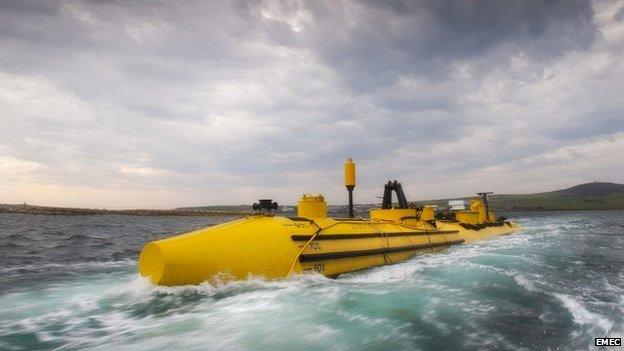
No energy source is perfect.
Fossil fuels emit damaging CO2, wind and solar are variable, nuclear generates radioactive waste, while biomass, depending on the source, can encourage deforestation.
On paper, tidal and wave power would appear to be the best solution, using the ferocious force of the oceans to deliver clean, abundant and consistent energy.
Yet despite the fact the first large-scale tidal project opened in La Rance in France in the 1960s, sea power provides just a fraction of the energy delivered by its renewable counterparts - currently just 0.5GW compared with almost 400GW of wind power.
But renewed determination to develop new technologies to harness the ocean's power means the tidal industry could be set for something of a renaissance.
World first
A tidal project similar to that in La Rance has been built in South Korea, with smaller plants in China, Canada and Australia. Together, these make up nearly all the tidal power generated across the world.
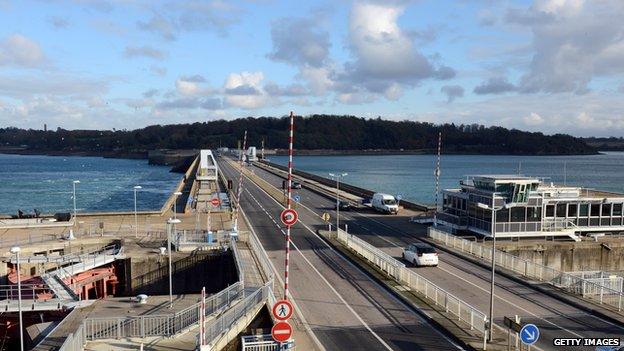
France's La Rance, opened in 1966, was the world's first tidal barrage
The world's first man-made tidal lagoon in Swansea Bay in Wales is currently awaiting planning permission, while the developer behind the scheme has plans for a further five projects around the UK.
All take advantage of what is called the tidal range - the change in the height of water between low and high tides. An artificial barrier is built, generally across an estuary, to hold water when the tide goes out. This water is then let back into the sea, driving turbines in the process. When the tide is high, the water is let back in, again driving the turbines.

In fact, the basic process is very similar to that used in hydropower stations across the world.
The problem, as Cedric Philibert at the International Energy Agency (IEA) explains, is that: "You can only make a tidal barrage where there is a huge difference in sea levels, and there are only a limited number of places where this happens, mainly Canada, Northern Europe and Korea."
There are also some environmental concerns, particularly with building barriers across estuaries, which are biologically very diverse and home to fish nurseries. Mr Philibert says it took 20 years for the natural environment to recover fully from the La Rance barrage.
He says artificial lagoons, such as that proposed in Swansea, are far less disruptive.
Powerful currents
But other technologies could help to unleash the true potential of tidal power.
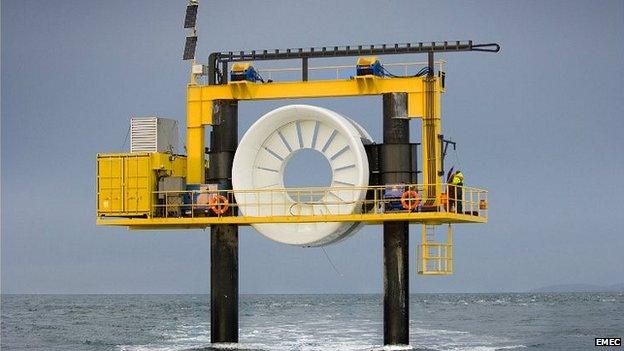
There are numerous different designs being developed to harness the power of tidal currents
The 1.2MW Seageneration project in Strangford Lough in Northern Ireland, installed in 2008, generates energy from tidal currents, rather than range. Two horizontal axis turbines are anchored to the seabed and are driven by the powerful currents resulting from the tide moving in and out.
As an important area for nature conservation, extensive environmental impact studies have been carried out and, according to Dee Nunn at Renewable UK, "no concerns have been realised".
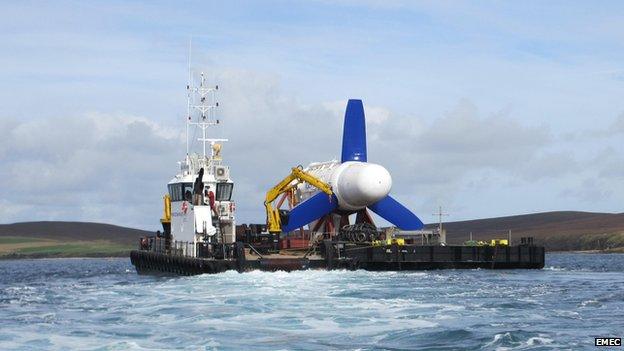
Many tidal turbine designs are similar to those used to capture wind, using ocean currents to drive three blades
The proposed MeyGen project in the Pentland Firth in Scotland aims to take tidal power to the next level, with a number of more traditional, three-bladed turbines producing almost 400MW by the early 2020s.
But this is just beginning.
Eight different technologies are currently being tested by the European Marine Energy Centre (Emec), based in Orkney off the northern coast of Scotland, one of the most fertile sites for both tidal and wave power and the only grid-connected test centre in the world.
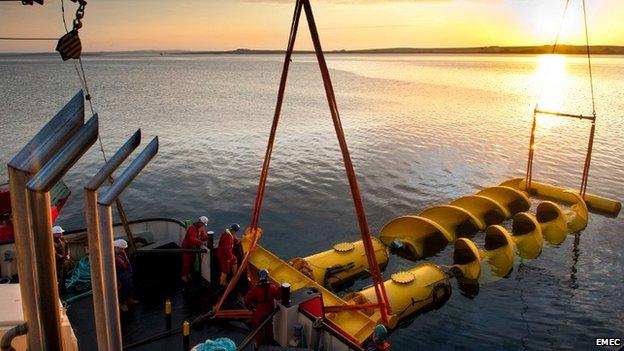
Some turbine designs are rather more radical, such as this from Norwegian company Flumill
These are being developed by a range of companies, from small dedicated tidal firms to big utilities and energy equipment manufacturers, and include all manner of different designs, external, from seabed and floating turbines to corkscrews and circular rings with rotors.
Swedish company Minesto is even pioneering a system where kites tethered to the seabed effectively fly on the currents.
And because they rely on tidal currents rather than differences in sea height, "these in-stream technologies could be used on a much larger scale", says Mr Philibert.
Choppy waters
But even the potential of tidal stream energy is overshadowed by that of wave power. Tidal turbines still need fast currents to generate worthwhile amounts of power, and so are well-suited to the edge of islands and, particularly, the inlets between them.
Waves are everywhere where there is good wind speed.
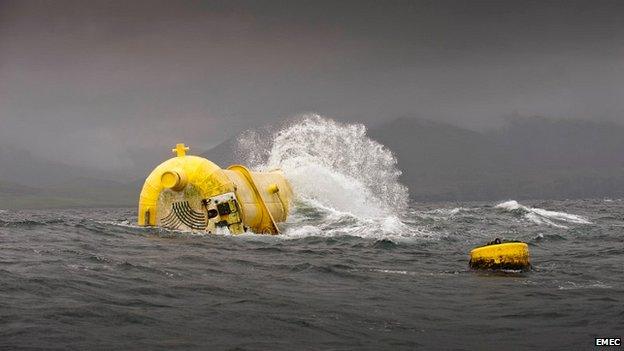
Waves are an even greater potential source of energy than tides
The problem has been developing a system that is robust enough to cope with the extreme conditions of the open waters, not least the need to cope with a hundred-year wave.
As Ms Nunn says, "This is proving more difficult [than tidal]."
Since 2011, the 300kW Mutriku wave project has been operating in Spain, but this is a rare exception.
Scottish wave power company Pelamis is a case in point. Despite being a pioneer in the industry, developing its first prototype in 2004 and having successfully generated 250MW/h of electricity, the firm went into administration late last year. Others are also struggling to attract sufficient investment.
But many firms have been able to secure funding, and are continuing to develop various technologies, with four companies currently in testing, external at Emec.
Australian company Carnegie Wave Energy is also making great strides using large buoys 20 metres in diameter, sitting under the surface of the water, says Ms Nunn.
High costs
All these technologies are a long way from commercialisation, and there has been some frustration at the pace of development of both tidal and wave power.
As Lisa MacKenzie at Emec says, "Everyone was expecting to progress faster and some have been a little over-optimistic."
The main barrier is cost. For example the test phase of the MeyGen project, involving four turbines generating 6MW of power, will cost £50m. When competing against more advanced clean technologies such as wind and solar, this can be hard to justify.
Any truly transformative technology takes time and money, but ocean power has plenty of potential. In the UK, for example, the Carbon Trust says tidal and wave power could meet 20% of the country's total energy needs.
With new projects likely to open in France, the UK, Canada and Korea in the coming years, the IEA forecasts global ocean power generation to double to 1GW by 2020.
High costs and the very challenging ocean environment will continue to hamper development, but the industry is confident these barriers can be overcome, with tidal and wave power eventually making a meaningful contribution to global energy supply.
Governments may have to contribute a greater share of the development costs, but this could be a small price to pay for harnessing this immense source of clean, predictable energy.